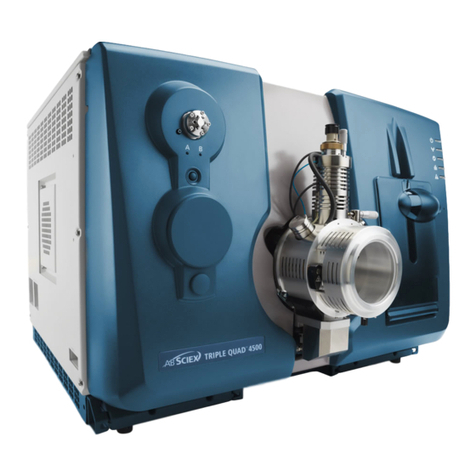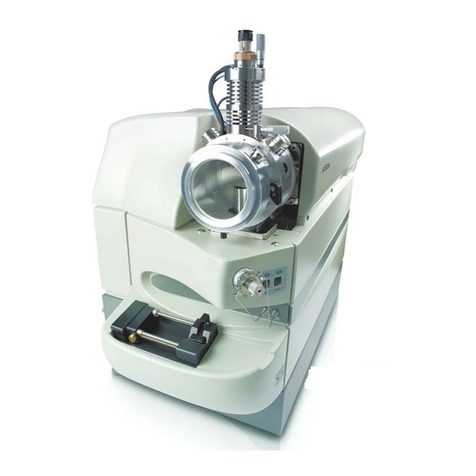
System Overview
6 Document Number: D1000092206 B
fragment ions for determining the exact quantity of the compound in the sample
of interest. Quantitation is performed using a standard curve of mass
spectrometer signal intensity for various known concentrations of the compound.
The signal in the test sample is compared to the standard curve to determine the
concentration.
The typical scan type used for this application in the API 5000 system, as well as
all triple quadrupole instruments, is MRM (Multiple Reaction Monitoring).
Features of the Instrument
The API 5000 LC/MS/MS system combines all of the features of the API 4000™
LC/MS/MS system with the additional benefits of improved sensitivity and
enhanced signal-to-noise ratio. It allows comprehensive analysis of
biopharmaceutical compounds and it has the specificity needed for new drug
development. It has the following features:
•A wide diameter intake orifice which improves sensitivity by flowing more
ions into the vacuum chamber.
•A QJet®ion guide that prefocuses the ions before they enter the vacuum
chamber for higher sensitivity and signal-to-noise ratio.
•Improved Q2 lenses reduce CAD gas leakage into the vacuum chamber
and improve sensitivity and signal-to-noise ratio.
•Higher quadrupole operating frequency, which improves ion transmission
and increases sensitivity, especially for low ion masses.
•Higher sensitivity in all RF/DC scan modes.
•Scanning in a mass range of m/z 5–1250 in quadrupole mode.
•Enhanced resolution at reduced scan speeds.
For pharmaceutical and pharmacokinetic samples, MS/MS has the sensitivity and
specificity needed to analyze hundreds of samples per day without requiring
extensive sample preparation.
How the Instrument Works
Mass spectrometry measures the mass-to-charge ratio of ions to identify
unknown compounds, to quantify known compounds, and to provide information
about the structural and chemical properties of molecules. The API 5000 system
has a series of quadrupole filters that transmit ions according to their m/z (mass-
to-charge ratios). The first quadrupole in this series is the QJet ion guide located
between the orifice plate and Q0. The QJet ion guide does not filter ions, but
focuses them before they enter Q0. By prefocusing the larger ion flux created by
the wider orifice, the QJet ion guide increases instrument sensitivity and
improves the signal-to-noise ratio. In Q0 the ions are again focused before
passing into Q1.
Q1 is a filtering quadrupole that sorts the ions before they enter Q2. Q2 is a
collision cell in which ions can be broken into fragments by collisions with gas
molecules. This technique allows users to design experiments that measure the
m/z of product ions to determine the composition of the parent ions. After
passing through Q2 the ions enter Q3 for additional filtering, and then enter the
detector. In the detector, the ions create a current that is converted into a voltage
pulse. The voltage pulses leaving the detector are directly proportional to the
quantity of ions entering the detector. The instrument monitors these voltage
































